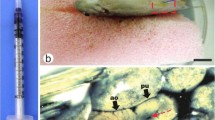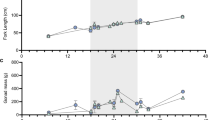Abstract
Our aim was to transplant blue catfish germ line stem cells into blastulae of triploid channel catfish embryos to produce interspecific xenogenic catfish. The morphological structure of the gonads of blue catfish (Ictalurus furcatus) in ~ 90- to 100-day-old juveniles, two-year-old juveniles, and mature adults was studied histologically. Both oogonia (12–15 μm, diameter with distinct nucleus 7–8 μm diameter) and spermatogonia (12–15 μm, with distinct nucleus 6–7.5 μm diameter) were found in all ages of fish. The percentage of germ line stem cells was higher in younger blue catfish of both sexes. After the testicular tissue was trypsinized, a discontinuous density gradient centrifugation was performed using 70, 45, and 35% Percoll to enrich the percentage of spermatogonial stem cells (SSCs). Four distinct cell bands were generated after the centrifugation. It was estimated that 50% of the total cells in the top band were type A spermatogonia (diameter 12–15 μm) and type B spermatogonia (diameter 10–11 μm). Germ cells were confirmed with expression of vasa. Blastula-stage embryos of channel catfish (I. punctatus) were injected with freshly dissociated blue catfish testicular germ cells as donor cells for transplantation. Seventeen days after the transplantation, 33.3% of the triploid channel catfish fry were determined to be xenogenic catfish. This transplantation technique was efficient, and these xenogenic channel catfish need to be grown to maturity to verify their reproductive capacity and to verify that for the first time SSCs injected into blastulae were able to migrate to the genital ridge and colonize. These results open the possibility of artificially producing xenogenic channel catfish males that can produce blue catfish sperm and mate with normal channel catfish females naturally. The progeny would be all C × B hybrid catfish, and the efficiency of hybrid catfish production could be improved tremendously in the catfish industry.







Similar content being viewed by others
References
Dunham RA (2011) Aquaculture and fisheries biotechnology: genetic approaches, 2nd edn. CABI Publishing, Cambridge, MA. https://doi.org/10.1079/9781845936518.0000
Dunham RA, Argue BJ (2000) Reproduction among channel catfish, blue catfish, and their F1 and F2 hybrids. Trans Amer Fish Soc 129(1):222–231. https://doi.org/10.1577/1548-8659(2000)129<0222:RACCBC>2.0.CO;2
Emmert-Buck MR, Bonner RF, Smith PD, Chuaqui RF, Zhuang Z, Goldstein SR, Weiss RA, Liotta LA (1996) Laser capture microdissection. Science 274(5289):998–1001. https://doi.org/10.1126/science.274.5289.998
Espina V, Heiby M, Pierobon M, Liotta LA (2007) Laser capture microdissection technology. Expert Rev Mol Diagn 7(5):647–657. https://doi.org/10.1586/14737159.7.5.647
Fan L, Alestrom A, Alestrom P, Collodi P (2004) Production of zebrafish germline chimeras from cultured cells. In: Schatten H (ed) Methods in molecular biology: germ cell protocols, volume 2: molecular embryo analysis, live imaging, transgenesis, and cloning. Humana Press, Totowa, pp 289–299
Gibbs PD, Schmale MC (2000) GFP as a genetic marker scorable throughout the life cycle of transgenic zebra fish. Mar Biotechnol 2(2):107–125
Grizzle JM, Rogers WA (1976) Anatomy and histology of the channel catfish. U.S. Department of Commerce, National Oceanic and Atmospheric Administration. Auburn Printing, Inc, Auburn, AL, pp 66–70
Higaki S, Eto Y, Kawakami Y, Yamaha E, Kagawa N, Kuwayama M, Katagiri S, Takahashi Y (2010) Production of fertile zebrafish (Danio rerio) possessing germ cells (gametes) originated from primordial germ cells recovered from vitrified embryos. Reprod 139(4):733–740. https://doi.org/10.1530/REP-09-0549
Higaki S, Mochizuki K, Baba H, Akashi Y, Yamaha E, Katagiri S, Takahashi Y (2009) Feasibility of cryopreservation of zebrafish (Danio rerio) primordial germ cells by whole embryo freezing. Jpn J Vet Res 57(2):119–128
Honaramooz A, Megee SO, Dobrinski I (2002) Germ cell transplantation in pigs. Biol Reprod 66(1):21–28. https://doi.org/10.1095/biolreprod66.1.21
Hutson AM (2006) Evaluation of LHRHa implants and injections on the production of channel catfish (Ictalurus punctatus) female × blue catfish (Ictalurus furcatus) male fry. M.S. Thesis, Auburn University, Auburn, AL
Johnson R, Wolf J, Braunbeck T (2009) OECD guidance document for the diagnosis of endocrine-related histopathology of fish gonads. OECD pp. 55, 88
Kang SJ, Choi JW, Kim SY, Park KJ, Kim TM, Lee YM, Kim H, Lim JM, Han JY (2008) Reproduction of wild birds via interspecies germ cell transplantation. Biol Reprod 79(5):931–937. https://doi.org/10.1095/biolreprod.108.069989
Kise K, Yoshikawa H, Sato M, Tashiro M, Yazawa R, Nagasaka Y, Takeuchi Y, Yoshizaki G (2012) Flow-cytometric isolation and enrichment of teleost type A spermatogonia based on light-scattering properties. Biol Reprod 86:1–12
Kobayashi T, Yoshizaki G, Takeuchi Y, Takeuchi T (2004) Isolation of highly pure and viable primordial germ cells from rainbow trout by GFP-dependent flow cytometry. Mol Reprod Dev 67(1):91–100. https://doi.org/10.1002/mrd.20003
Kristanto AH, Umali G, Beam R, Dunham RA (2009) Effect of postmanufacturing processing and shipping of luteinizing hormone releasing hormone analog on induced ovulation for production of channel catfish female × blue catfish male hybrid fry. N Amer J Aquacult 71(4):307–311. https://doi.org/10.1577/A07-099.1
Lacerda SMSN, Aponte PM, Costa GMJ, Campos-Junior PHA, Segatelli TM, Silva MA, França LR (2012) An overview of spermatogonial stem cell physiology, niche and transplantation in fish. Anim Reprod 9:798–808
Lacerda SMSN, Batlouni SR, Costa GMJ, Segatelli TM, Quirino BR, Queiroz BM, Kalapothakis E, França LR (2010) A new and fast technique to generate offspring after germ cells transplantation in adult fish: the Nile tilapia (Oreochromis niloticus) model. PLoS One 5(5):e10740. https://doi.org/10.1371/journal.pone.0010740
Lacerda SMSN, Batlouni SR, Silva SBG, Homem CSP, França LR (2006) Germ cells transplantation in fish: the Nile-tilapia model. Anim Reprod 3:146–159
Lacerda SMSN, Costa GM, Campos-Junior PH, Segatelli TM, Yazawa R, Takeuchi Y, Morita T, Yoshizaki G, França LR (2013) Germ cell transplantation as a potential biotechnological approach to fish reproduction. Fish Physiol Biochem 39(1):3–11. https://doi.org/10.1007/s10695-012-9606-4
Lilyestrom CF, Wolters WR, Bury D, Rezk M, Dunham RA (1999) Growth, carcass traits, and oxygen tolerance of diploid and triploid catfish hybrids. N Amer J Aquacult 61(4):293–303. https://doi.org/10.1577/1548-8454(1999)061<0293:GCTAOT>2.0.CO;2
Okutsu T, Shikina S, Kanno M, Takeuchi Y, Yoshizaki G (2007) Production of trout offspring from triploid salmon parents. Science 317(5844):1517. https://doi.org/10.1126/science.1145626
Okutsu T, Suzuki K, Takeuchi Y, Takeuchi T, Yoshizaki G (2006a) Testicular germ cell can colonize sexually undifferentiated embryonic gonad and produce functional egg in fish. Proc Natl Acad Sci U S A 103(8):2725–2729. https://doi.org/10.1073/pnas.0509218103
Okutsu T, Yano A, Nagasawa K, Shikina S, Kobayashi T, Takeuchi Y, Yoshizaki G (2006b) Manipulation of fish germ cell: visualization, cryopreservation and transplantation. J Reprod Dev 52(6):685–693. https://doi.org/10.1262/jrd.18096
Panda RP, Barman HK, Mohapatra C (2011) Isolation of enriched carp spermatogonial stem cells from Labeo rohita testis for in vitro propagation. Theriogenology 76(2):241–251. https://doi.org/10.1016/j.theriogenology.2011.01.031
Patiño R, Davis KB, Schoore JE, Uguz C, Strüssmann CA, Parker NC, Simco BA, Goudie CA (1996) Sex differentiation of channel catfish gonads: normal development and effects of temperature. J Exp Zool 276(3):209–218. https://doi.org/10.1002/(SICI)1097-010X(19961015)276:3<209::AID-JEZ5>3.0.CO;2-R
Perera DA, Alsaqufi A, Shang M, Wade DC, Su B, Elaswad A, Fobes M, Beam R, Garcia G, Dunn D, Lipke E, Dunham RA (2016) Xenogenesis: production of channel catfish × blue catfish hybrid progeny by fertilization of channel catfish eggs with sperm from triploid channel catfish males with transplanted blue catfish germ cells. N Amer J Aquacult 79:61–74
Saito T, Goto-Kazeto R, Arai K, Yamaha E (2008) Xenogenesis in teleost fish through generation of germ-line chimeras by single primordial germ cell transplantation. Biol Reprod 78(1):159–166. https://doi.org/10.1095/biolreprod.107.060038
Saito T, Goto-Kazeto R, Fujimoto T, Kawakami Y, Arai K, Yamaha E (2010) Inter-species transplantation and migration of primordial germ cells in cyprinid fish. Int J Dev Biol 54(10):1481–1486. https://doi.org/10.1387/ijdb.103111ts
Selman K, Wallace RA, Sarka A, Qi X (1993) Stages of oocyte development in the zebrafish, Brachydanio rerio. J Morphol 218(2):203–224. https://doi.org/10.1002/jmor.1052180209
Shang M, Su B, Lipke EA, Perera DA, Li C, Qin Z, Li Y, Dunn DA, Cek S, Peatman E, Dunham RA (2015) Spermatogonial stem cells specific marker identification in channel catfish, Ictalurus punctatus and blue catfish, I. furcatus. Fish Physiol Biochem 41(6):1545–1556. https://doi.org/10.1007/s10695-015-0106-1
Sheehan DC, Hrapchak BB (1987) In: Battelle Press (ed) Theory and practice of histotechnology, 2nd edn, Columbus, Ohio, pp 40–58
Shikina S, Ihara S, Yoshizaki G (2008) Culture conditions for maintaining the survival and mitotic activity of rainbow trout transplantable type A spermatogonia. Mol Reprod Dev 75(3):529–537. https://doi.org/10.1002/mrd.20771
Silverstein JF, Small BC (2000) Reproductive physiology. In: Tucker CS, Hargreaves JA (eds) Biology and culture of channel catfish. Elsevier Inc., San Diego, CA, p 87
Su B, Perera DA, Zohar Y, Abraham E, Stubblefield J, Fobes M, Beam R, Argue B, Ligeon C, Padi J, Waters P, Umali-Maceina G, Chatakondi N, Kristanto A, Hutson A, Templeton C, Ballenger J, Chaimongkol A, Gima A, Gima M, Zuberi A, Lambert DM, Kim S, Mandour M, Dunham RA (2013) Relative effectiveness of carp pituitary extract, LHRHa injections and LHRHa implants for producing hybrid catfish fry. Aquaculture 372-375:133–136. https://doi.org/10.1016/j.aquaculture.2012.10.001
Su B, Peatman E, Shang M, Thresher R, Grewe P, Patil J, Pinkert C, Irwin M, Li C, Perera D, Duncan PL, Fobes M, Dunham RA (2014) Expression and knockdown of primordial germ cell genes, vasa, nanos and dead end in common carp (Cyprinus carpio) embryos for transgenic sterilization and reduced sexual maturity. Aquaculture 420-421:S72–S84. https://doi.org/10.1016/j.aquaculture.2013.07.008
Takeuchi Y, Higuchi K, Yatabe T, Miwa M, Yoshizaki G (2009) Development of spermatogonial cell transplantation in nibe croaker, Nibea mitsukurii (Perciformes, Sciaenidae). Biol Reprod 69:1055–1063
Takeuchi Y, Yoshizaki G, Kobayashi T, Takeuchi T (2002) Mass isolation of primordial germ cells from transgenic rainbow trout carrying the green fluorescent protein gene driven by the vasa gene promoter. Biol Reprod 67(4):1087–1092. https://doi.org/10.1095/biolreprod67.4.1087
Takeuchi Y, Yoshizaki G, Takeuchi T (2003) Generation of live fry from intraperitoneally transplanted primordial germ cells in rainbow trout. Biol Reprod 69(4):1142–1149. https://doi.org/10.1095/biolreprod.103.017624
Waldbieser GC, Bosworth BG (2008) Utilization of a rapid DNA-based assay for molecular verification of channel catfish, blue catfish, F1 hybrids, and backcross offspring at several life stages. N Amer J Aquacult 70(4):388–395. https://doi.org/10.1577/A07-076.1
Wong TT, Saito T, Crodian J, Collodi P (2011) Zebrafish germline chimeras produced by transplantation of ovarian germ cells into sterile host larvae. Biol Reprod 84(6):1190–1197. https://doi.org/10.1095/biolreprod.110.088427
Xu HY, Li MY, Gui JF, Hong YH (2010) Fish germ cells. Science China Life Sci 53:435–446
Yoshikawa H, Morishima K, Fujimoto T, Saito T, Kobayashi T, Yamaha E, Arai K (2009) Chromosome doubling in early spermatogonia produces diploid spermatozoa in a natural clonal fish. Biol Reprod 80(5):973–979. https://doi.org/10.1095/biolreprod.108.075150
Yoshizaki G, Ichikawa M, Hayashi M, Iwasaki Y, Miwa M, Shikina S, Okutsu T (2010a) Sexual plasticity of ovarian germ cells in rainbow trout. Development 137(8):1227–1230. https://doi.org/10.1242/dev.044982
Yoshizaki G, Okutsu T, Ichikawa M, Hayashi M, Takeuchi Y (2010b) Sexual plasticity of rainbow trout germ cells. Anim Reprod 7:187–196
Yoshizaki G, Takeuchi Y, Sakatani S, Takeuchi T (2000) Germ cell-specific expression of green fluorescent protein in transgenic rainbow trout under control of the rainbow trout vasa-like gene promoter. Int J Dev Biol 44(3):323–326
Zwada WM, Cibelli JB, Choi PK et al (1998) Somatic cell cloned transgenic bovine neurons for transplantation in parkinsonian rats. Nat Med 4(5):569–574. https://doi.org/10.1038/nm0598-569
Funding
This work was partially funded by the USDA-Biotechnology Risk Assessment Program (grant no.: 2009-33522-05774), the Alabama Agricultural Experiment Station (80-009), and the Office of the Vice President for Research, Auburn University (OVPR-AU-IGP).
Author information
Authors and Affiliations
Corresponding author
Ethics declarations
All the procedures involving the handling of fish during this study were approved by the Auburn University Institutional Animal Care and Use Committee (PRN-2013-2224).
Additional information
Mei Shang and Baofeng Su are co-first authors.
Electronic supplementary material
Supplementary figure 1
(DOCX 14kb).
Rights and permissions
About this article
Cite this article
Shang, M., Su, B., Perera, D.A. et al. Testicular germ line cell identification, isolation, and transplantation in two North American catfish species. Fish Physiol Biochem 44, 717–733 (2018). https://doi.org/10.1007/s10695-018-0467-3
Received:
Accepted:
Published:
Issue Date:
DOI: https://doi.org/10.1007/s10695-018-0467-3




